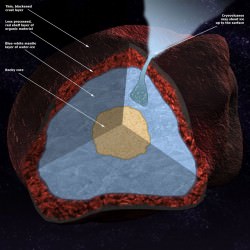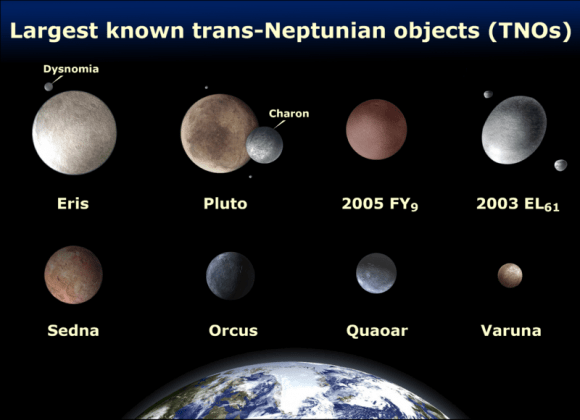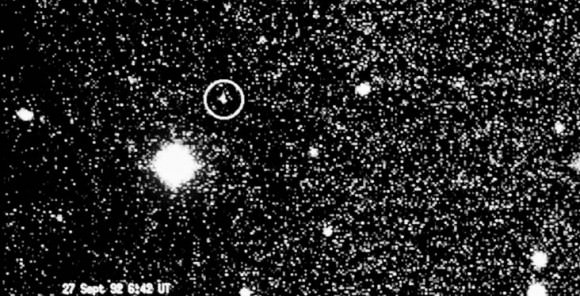Over 4 billion miles (6.7 billion km) from the Sun, the Kuiper Belt is a vast zone of frozen worlds we still know very little about. Image: Johns Hopkins University Applied Physics Laboratory/Southwest Research Institute (JHUAPL/SwRI)
Today marks the 20th anniversary of the discovery of the first Kuiper Belt Object, 1992QB1. KBOs are distant and mostly tiny worlds made up of ice and rock that orbit the Sun at incredible distances, yet are still very much members of our Solar System. Since 1992 over 1,300 KBOs have been found, and with NASA’s New Horizons spacecraft speeding along to its July 2015 rendezvous with Pluto and Charon (which one could argue are technically the first KBOs ever found) and then onwards into the Belt, we will soon know much more about these far-flung denizens of deep space.
But how has the discovery of the Kuiper Belt — first proposed by Gerard Kuiper in 1951 (and in a fashion even earlier by Kenneth Edgeworth) — impacted our current understanding of the Solar System? New Horizons Principal Investigator Alan Stern from the Southwest Research Institute recently discussed this on his mission blog, “The PI’s Perspective.”
 First, Stern lists some of the surprisingly diverse physical aspects of KBOs that have been discovered so far:
First, Stern lists some of the surprisingly diverse physical aspects of KBOs that have been discovered so far:
- Some are red and some are gray;
- The surfaces of some are covered in water ice, but others (like Pluto) have exotic volatile ices like methane and nitrogen;
- Many have moons, though none with more known moons than Pluto;
- Some are highly reflective (like Pluto), others have much darker surfaces;
- Some have much lower densities than Pluto, meaning they are primarily made of ice. Pluto’s density is so high that we know its interior is about 70% rock in its interior; a few known KBOs are more dense than Pluto, and even rockier!
But although these features are fascinating in themselves, just begging for further exploration, Stern notes that there are three very important lessons that the Kuiper Belt has taught us about the Solar System:
1. Our planetary system is much larger than we had ever thought.
“In fact, we were largely unaware of the Kuiper Belt — the largest structure in our solar system — until it was discovered 20 years ago,” Stern writes. “It’s akin to not having maps of the Earth that included the Pacific Ocean as recently as 1992!”
2. Planetary locations and orbits can change over time.
“This even creates whole flocks of migration of planets in some cases. We have firm evidence that many KBOs (including some large ones like Pluto), were born much closer to the Sun, in the region where the giant planets now orbit.”
3. Our solar system, and likely others as well, was very good at making small planets.
“Today we know of more than a dozen dwarf planets in the solar system, and those dwarfs already outnumber the number of gas giants and terrestrial planets combined. But it is estimated that the ultimate number of dwarf planets we will discover in the Kuiper Belt and beyond may well exceed 10,000. Who knew?”
And with a little jab at the whole Pluto-isn’t-a-planet topic, Stern asks: “And which class of planet is the misfit now?”
Read: Was Pluto Ever REALLY a Planet?
The discovery of the Kuiper Belt has shown us that our solar system — and very likely planetary systems across the galaxy, even the Universe — aren’t neat and tidy things that can be easily summed up with grade-school models or chalkboard diagrams. Instead they are incredibly diverse and dynamic, continually evolving and consisting of countless, varied worlds spanning enormous distances… yet still connected through the ever-present effects of gravity (not to mention the occasional-yet-unavoidable collision.)
“What an amazing set of paradigm shifts in our knowledge the Kuiper Belt has brought so far. Our quaint 1990s and earlier view of the solar system missed its largest structure!”
– Alan Stern, New Horizons Principal Investigator
Read more about the New Horizons mission here.
The first KBO identified, 1992 QB1 (European Southern Observatory)



